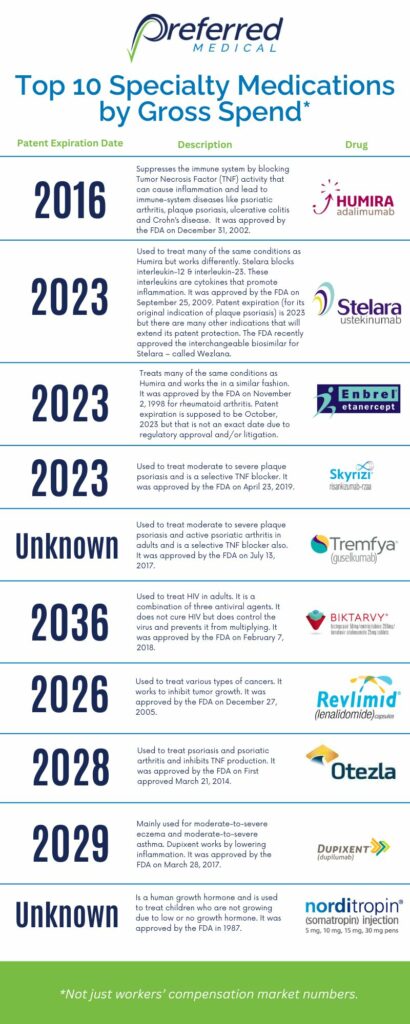
With advancements in science and technology in the past 30 years, a distinct trend has emerged in the pharmaceutical industry. Pharmaceutical manufacturers have expanded their pipelines to launch new ‘specialty’ drugs designed to treat rare, complex, chronic diseases like cancer, rheumatoid arthritis, and multiple sclerosis. What follows is an overview of the specialty drug market and what this means for workers’ compensation.
Adoption of these specialty drugs, also referred to as biologics, has been rapid from the 1990s to the 2000s, growing from 30 to more than 500. By the end of 2023, 65% of new drug launches are expected to be specialty drugs. Driven by the introduction of new therapies, price increases, and expanded indications, these high-cost prescription medications are expected to account for more than 50% of total drug spending by the end of this year.
While most drugs are chemicals synthesized from other chemicals, biologics are much more expensive due to their complex manufacturing process. So, not only do they cost more to develop, but they also take longer to develop than traditional drugs.
Specialty drugs sometimes require special handling and administration (typically injection or infusion), and patients using a specialty drug may need careful oversight from a healthcare provider who can watch for side effects and ensure that the medication is working as intended.
There are hundreds of unique specialty drugs in more than 40 therapeutic categories and specialty disease states on the market today. This number is expected to increase, as nearly two-thirds of the 600 drugs which won FDA approval in 2022 (some 400 drugs) were specialty drugs.
Specialty drugs are very expensive – often $1,000 or more per month – and spending on them is growing 15 to 20 percent a year. Because of their high cost, there is a great demand for generic versions of biologics. In recent years, numerous biosimilars (also called a reference product) have entered the market, usually at a much lower cost than the original biologic they’re based on. They’re not exactly generics, but according to the FDA, a biosimilar is a biologic that is highly similar to and has no clinically meaningful differences in terms of purity and potency (safety and effectiveness) from an existing FDA-approved biologic.
 How do you know if a drug is a specialty drug?
How do you know if a drug is a specialty drug?
The Centers for Medicare and Medicaid Services (CMS) defines a specialty drug as one that costs $670.00 a month or more. Other stakeholders, including the FDA, have different criteria to define this fast-growing drug category. Not surprisingly, most of the drugs you see on television or those being advertised on the internet today are specialty drugs.
What is the impact on workers’ compensation payers currently and in the future?
While this is interesting from a total United States drug trend perspective, many industry sources report that specialty drugs presently account for a small percentage (less than 2.5% of transactions), but a larger percentage of cost (more than 6.5%) which is increasing significantly year-over-year.
What can payers do to make sure injured workers are getting the appropriate medication for the accepted industrial claims?
Specialty drug management is becoming more complex and challenging, as payers face increasing pressure to balance access, quality, and affordability. Payers need to adopt a holistic and integrated approach that leverages data analytics, clinical expertise, and innovative contracting models.
Specialty drug management is challenging for workers’ compensation payers, who face barriers such as limited access to clinical data, complex authorization processes, fragmented care delivery, and regulatory variations across states.
While there is not a single answer for this, there are some critical and highly effective strategies a payer can easily implement.
- Make sure that you understand cases where longer-term, chronic treatments are affecting your injured worker’s recovery, both physical and mental.
- Avoid rubber-stamping high-dollar medications without understanding why that medication is being prescribed and how the anticipated outcome affects the overall quality of medical care.
- Have a reliable clinical partner who can provide input rapidly without contributing to the fragmentation of ongoing medical care.
- Double-check to see if there is a biosimilar approved by the FDA that can mitigate the brand name list price.
- Finally, develop a continuous feedback loop to monitor holistic outcomes for the injured worker and avoid polypharmacy approaches that over-medicate without measurable benefits.
Sources: The statistics referenced in this article were pulled from public sources, including the Specialty Drug Reports from Enlyte Group, LLC, Optum Workers’ Compensation, and Healthesystems.



